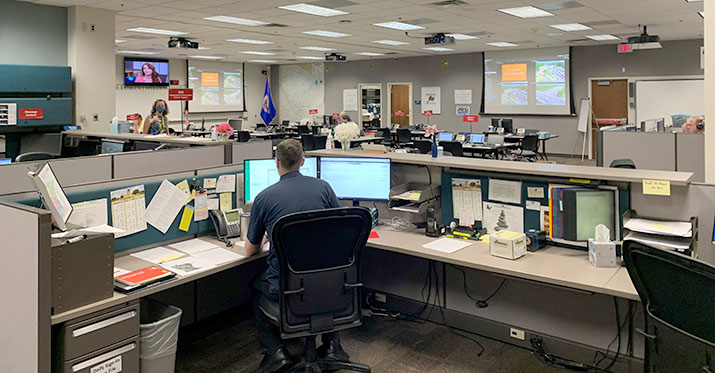The SEOC’s sustained response to COVID-19

The kinds of emergencies the State Emergency Operations Center (SEOC) usually deals with tend to have a beginning and an end. Snowmelt and heavy rains cause spring flooding, for example. But once the floodwaters recede and the community starts to rebuild, the SEOC can move from response mode to recovery mode, and then deactivate altogether – until the next emergency, anyway.
Not so with COVID-19. The Minnesota SEOC has been in active-response mode for 100 days as of this week, providing local entities responding to the pandemic with coordination and resources for testing and personal protective equipment (PPE). The SEOC has also been providing guidance documents for opening back up and supporting local emergency managers, and it’s the place where state agencies and work groups gather to respond to the incident. The Federal Emergency Management Agency (FEMA) funding that the SEOC coordinates will help support supplemental nutrition programs, medical assistance, funeral assistance, legal services and statewide hazard mitigation.
But doing this active response work for over three months has exhausted some resources, both human and financial. Since March, the SEOC has completed more than 200 requests for resources or personnel, with dozens more waiting to be fulfilled every day. These requests range from simple cardboard boxes, to testing kits, to nursing staff, to bleach, to hand sanitizer and various types of PPE. And although they have done as much of the work remotely as possible, the SEOC has served as an office for anywhere between 50 to 100 people on any given day. They mask up, follow social distancing protocol, and adhere to disinfecting practices. Recently, all SEOC workers were tested for COVID-19, and all results came back negative.
Before COVID-19 interrupted our daily routine, Gov. Tim Walz recommended $29.545 million as part of his bonding package to acquire land to design, develop, construct, and equip a new SEOC. That measure is once again under consideration by the legislature during the special session. If this pandemic has taught us anything, it’s that having an adequate facility to coordinate this response and recovery work is essential to ensuring the safety of all Minnesotans in an emergency.
Considering that COVID-19 is turning out to be a long-term problem with a possible second wave in the fall, the SEOC needs to move from the active response described above to a sustained response. Some state agency staff members will return to their normal work. That includes planning for other types of emergencies, because our best defense in any emergency is a good plan. So while there may be fewer people staffing the SEOC on any given day, and resources may be distributed on a different schedule, the SEOC hasn’t forgotten about COVID-19. Other emergencies won’t stop, so they need to be able to divert some time and attention to incidents like flooding and tornadoes as they come up. The bottom line? The SEOC must be ready to help Minnesotans on their worst day, no matter what that looks like.

